#lost ! belgian cuisine
Explore tagged Tumblr posts
Text
belgian cuisine
travelling to belgium to film a music video was exciting, but there was something about belgium that was more exciting than the music video filming: the food. noel didn’t actually know much about belgian food, but he was still excited to try it. noel was a food lover, he valued food and was excited to taste something new, something he couldn’t get in korea.
on their off day, noel finds himself along haneul ( @behaneul ) , the other seeming just as interested in trying the belgian food as noel is. “i’ve heard they got good beers too” he nods a bit, looking shortly at haneul before returning his look to the camera. “fries are belgian, aren’t they? i feel like we need to try them, i’m curious if they’re different from fries in korea and canada”. “is there any food you’d like to try?”.
#it's been put in...→ queue#noelxbe#less lost ... thread !#less ! haneul#behaneul#lost ! belgian cuisine#( just tell me if i should change anything ! )#noelxbe: writing challenge jan 2025#lime:vybemission1#( date: january 13th )
2 notes
·
View notes
Text



Willy Slawinski
Apicius: the name of his restaurant?
In Imperial Rome luxurious dinning brought fame to chefs, their popularity often exceeded that of philosophers and poets. Born about 25BC Marcus Gavius Apicius, great epicurean and gastronomist left us 10 handwritten manuscripts, printed later, such as “De Re Coquinaria” (“the kitchen manual”) filled with the essentials of cooking.
Marcus Apicius stated: “Nothing pleasant can be achieved by excluding the delights of table and bed”. With a legendary reputation for exuberant fests and a close friend of Cesar Heliogabalus, he taught eating and feeding skills in Rome. Many disciples gathered around his bed covered in roses where he shared his recipes.
His manuscripts contained the foundation of many dishes, by his creation or by perfecting existing recipes such as blood sausage, ragout, sole gratin, stew, duck with turnips, sausage of pork liver, bouillabaisse, and named after him: “paté in crust” with pork, fish and chicken. A skilled chemist, he knew covering vegetables and adding salt or honey preserved them longer, cooking with niter kept the vegetables green. He named several cakes, and excelled in creating tasty sauces, combining herbs, sweet and bitter or sweet and salty flavors matching them with robust wines. One of the first master Chefs.
My dad’s cooking journey
Although he never followed a formal education in cooking, he learned the classic cuisine by apprenticeship and developed his unique modern cuisine and philosophy over the years. Started at age 14 working in the kitchen, his curiosity and search for perfection was sparked. Born without nationality in 1948 in Waasmunster, Belgium from a Flemish mother and Polish father, who died when he was 11, he obtained the Belgian nationality but never lost his Slavic roots.
Dad at Restaurant “Villa Lorraine”
He moved with my mom Nicole to Brussels and worked as commis at “Villa Lorraine” one of the most reputable 3 Michelin star restaurants in Belgium in 1970. His nervous disposition and go-for-it attitude made him stand out amongst the French speaking tight brigade; he was nicknamed “ le petit flamand” (the little Flemish) and often on the receiving end of pranks. He worked really long hours, had a really hard time but after his shift he tested his creations at home to escape reality. When one day Chef Camille Leurquin, didn’t show up for work, the restaurant owner Marcel Kreusch, asked him to run service for an important dinner party, it needed perfection and he delivered. In 1978 he was ayoung chef running the 3 Michelin starred kitchen and service for 3 months and in return was rewarded with apprenticeships during his summer holidays with the biggest chefs in the world such as the brothers Troisgros, Alain Senderens, Alain Chapel, the brothers Haeberlin, Michel Guérard and Frédy Girardet. This rocked his world.
Dad’s cooking philosophy
He opened his own restaurant Apicius in April 1980 fueled with many ideas and his overpowering need for perfection; many a dish was thrown out and started over again until he was satisfied. He challenged everything and everyone around him but most of all himself; extreme in all he did he searched and pushed himself often to the limit. He took up cycling and took it to the extreme; he formed friendships with many athletes such as Eddy Merckx and road until he calmed the devil in him, about 200km per week. His constant companion was his Doberman Marcus Gavius, named after the same author he named his restaurant; he needed a dog with the same passion for life. Although the name of the restaurant was tribute to one of the first roman chefs, he also cleverly ensured it was neither a French nor Dutch name. “A” starting the alphabet, he would be listed first in guides also. His creativity triumphed and threw overboard all classical roadblocks and wanted to hang up the sign: “Laboratoire de cuisine” (kitchen laboratory). He hangs out with painters and writers, buys every modern and ancient cookbook he can find, as many books on herbs and edible plants, he studies, researches and develops his philosophy of the “la Cuisine Réfléchie” (the reflective cuisine).
He favors steaming fish and meat, experiments with reducing cooking times, prefers serving dishes lukewarm and cold soups, uses many new vegetables (such as romanesco cauliflower ), fresh herbs (such as pimpernel, angelic and red basil), woody mushrooms (testing their toxicity himself), edible flowers (such as bourrache (starflower), calendula (marigold), capucine (nasturtium), monarda, violets, roses & zucchini blossoms) and “exotic” ingredients (such as pâte a brick), a first ever and difficult to accept by some. He created a light cuisine, packed with flavor and easily digestible. He drastically reduced use of salt and replaces it with natural aromas such as celery. Acidities in fruits such as rhubarb, nuts such almonds give a natural bitterness and the scent of mushrooms provides depth to a dish. He is groundbreaking, a pioneer of his time! He creates dishes with combinations of ingredients never tasted before such as scallops with squid ink, duck with a chocolate sauce, langoustines with salsify with vanilla, little spinach parcels with pear and chocolate sauce, tartare of pineapple and carrots with Vacherin (cheese). He called it ‘Taste and Anti-Taste”: unusual combinations that come together in a surprising harmony. He removes salt and peppershakers from his tables and challenges his customers to really taste the flavors, the ingredients and the dish. He started working on his book where he was prepared to share his idea of a healthy and gastronomical cuisine opposing the rise of “fast food” and creating dessert without sugar nor flower. His vision for the future was a delicate balance between nourishment of body and soul and by pushing the boundaries of technology, this to obtain not only a culinary experience but also an emotive experience. He passed away in 1992 before finishing his book.
In 1982 he received his first public recognition “ la Clef d’Or” de GaultMillau. In 1984 he received his first Michelin star and his second star in 1986. The relationship with Michelin was always a difficult one; he felt misunderstood and was fighting against an institution wanting to save tradition by standing in the way of innovation.
In 2007 my mother, brother and I brought out a memoire of his work, using bits and pieces of what he wrote, some recipes, friends and family share stories of him and most of all his philosophy. Homarus published 2000 numbered books in French and Dutch.
By Sandra Slawinski from Leeks & High Heels
0 notes
Text

Do you dream about a trip to Europe filled with romance, history, and magnificent scenery? Look no farther than Alhijaz Holidays' exclusive Europe tour packages from Calicut, Kochi (Cochin), Trivandrum -Kerala. Our programs are tailored to perfection and provide an unforgettable vacation through France, Belgium, Holland, Italy, Germany, Switzerland, Austria, and the magnificent city of Venice. Explore these classic destinations with our effectively planned itineraries, which will make your European vacation really unforgettable.
Discover the Essence of Europe:
France - Romance in Paris:
Discover the charm of Paris, the City of Love, with our Paris trip packages. Wander hand in hand down the Seine River, admire the renowned Eiffel Tower, and savor wonderful French cuisine at small bistros. Allow Paris's charm to steal you away on an enthralling journey through its historic streets and scenic sites.
Italy - Marvels of Italy:
With our Italy tour packages, you may engage yourself in its beauty. From the ancient ruins of Rome to the charming canals of Venice, see this enchanting country's cultural riches and artistic past. Enjoy real Italian delicacies, discover centuries-old architecture, and make lasting memories against the backdrop of Italy's breathtaking landscapes.
Venice - Enchanting Venetian Getaway:
Embark on an incredible journey in Venice, a city unlike any other. Cruise along its serene canals in a traditional gondola, see the complex architecture of St. Mark's Square, and get lost in the maze of narrow lanes lined with hidden treasures. Our Venice tour packages provide a memorable experience in this timeless city of romance and mystery.
Explore Europe's Hidden Gems:
Belgium & Holland - Charm of the Low Countries:
Explore the hidden gems of Belgium and Holland, where medieval architecture meets vibrant modern culture. Explore Brussels' medieval streets, taste in beautiful Belgian chocolates, and see Holland's gorgeous tulip fields. Our Europe vacation packages from Kerala take you on a fascinating journey across the beautiful landscapes and cultural heritage of these beautiful nations.
Germany - Cultural Delights of Germany:
Explore Germany's rich cultural tapestry, from the fantasy castles of Bavaria to the busy streets of Berlin. Experience the Oktoberfest celebrations, discover Munich's historic sites, and relax in the picturesque splendor of the Black Forest. Our Europe tour package from Kerala promises an exciting experience of this diverse and dynamic country.
Switzerland & Austria - Alpine Splendor:
Enjoy yourself in the amazing glory of Switzerland and Austria, where snow-capped peaks and clear lakes await. Explore the picturesque villages of the Swiss Alps, take scenic train journeys through mountain valleys, and drink up Vienna's rich musical tradition. Our Europe Holiday package from Kerala takes you on a memorable journey through the alpine vistas and cultural wonders of these beautiful countries.
Book Your European Adventure Today:
With Alhijaz Holidays' Europe Holiday package from Kerala, you may embark on an exciting journey across Europe. Whether you're drawn to the romance of Paris, the allure of Italy, or the enchantment of Venice, our expertly crafted itineraries ensure an engaging and unforgettable journey. Contact us now to begin planning your dream European holiday and go on an incredible journey!
Visit Site:https://alhijaztravelsandtours.com/packages/europe-tour-packages/
Contact: +91 8086 511 511
0 notes
Text
Abhi in Paris
Week 3: Belgian Delights to Backpacking Dreams
Week three of my study abroad adventure in France has been nothing short of exhilarating. Over the weekend, I decided to venture beyond the borders of France and explore the charming city of Brussels. A quick trip to Quai de Bercy (the Paris City Centre Bus Station) and a four hour bus ride later, I was saying hello to Brussels! The journey began with iconic sights that left me in awe – from the Grand Place to the Atomium, each corner of the city seemed to tell a story of its own. However, what truly stole my heart were the delectable Belgian waffles and the exquisite Belgian beer that added a flavorful touch to my weekend escapade. My Belgian Waffle was covered in Whipped Cream and White Chocolate sauce and let me tell you, this might have been the sweetest & creamiest waffle I've ever eaten.
Returning to my studies on Monday was a stark contrast to the leisurely weekend, as I delved into classes and even faced my first homework assignment. I had to complete some Fourier Transform work in MatLab, and honestly, so far I've really enjoyed the French education systems. It's characterized by a longer semester allowing for a relaxed pace with less or no homework and more breaks in between. The academic challenges were complemented by a newfound passion – rowing. ENSEA, the school I am attending, offers a rowing club, and I decided to give it a try. I've rowed extensively in high school, but lost touch since then. The rhythmic motions of rowing against the serene backdrop of the French countryside provided a refreshing break from the intellectual pursuits.
As the week progressed, I found a balance between academia and recreation, allowing myself to fully immerse in the rich experiences that France has to offer. Thursday marked the beginning of my preparations for the upcoming break from school, where I'll be embarking on a 20-day backpacking journey through Spain and Portugal. The anticipation of exploring new cultures, landscapes, and cuisines fueled my excitement.
The weekend brought another round of adventures as I visited the enchanting Montmartre with my girlfriend Sneha from Michigan, who's also abroad in Paris studying at HEC Paris. The panoramic views of the city at sunset, the Wall of Love adorned with "I love you" declarations in countless languages, and the warming sensation of Vin Chaud (hot wine) made this day an unforgettable chapter of my journey. Each step I took seemed to lead me to a new discovery, a hidden gem waiting to be explored. The evening ended with a beautiful view of the sunset over Paris atop Montmarte with Sneha.
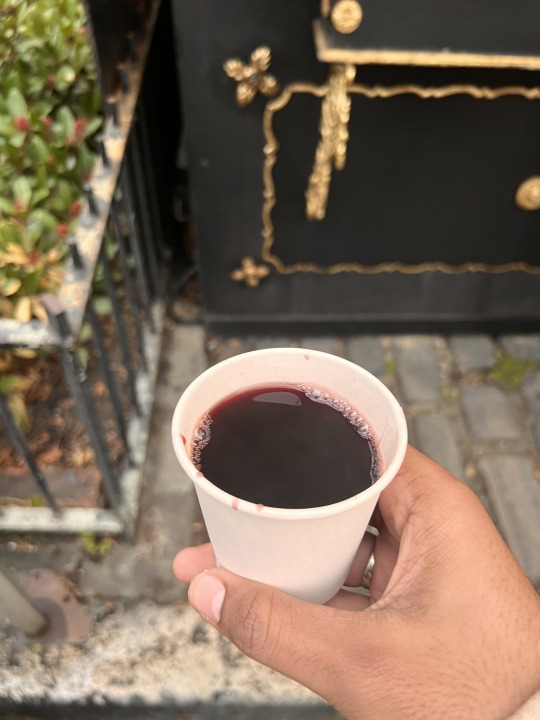


Also, super exciting--EVERYONE in Paris where's overcoats and as an early birthday gift, Sneha got me an amazing Parisian overcoat!

Sunday was dedicated to art and history at the Louvre. Standing before the iconic Mona Lisa, I couldn't help but feel a profound connection to the artistic legacy that has shaped the world. The Louvre itself, with its vast collection of masterpieces, offered a glimpse into the cultural tapestry of humanity.
Looking ahead, Thursday of the next week signals the beginning of my much-anticipated break from school. With a backpack on my shoulders and a spirit of adventure in my heart, I am set to explore the wonders of Spain and Portugal. The journey will include a few days of relaxation on the beaches of Tenerife, particularly Playa de Las Americas. As I packed my bags over the weekend, excitement and anticipation filled the air, knowing that new experiences and friendships await me on this backpacking odyssey.
In the midst of academia, rowing, and weekend explorations, my study abroad adventure in France continues to unfold with surprises and discoveries at every turn. Stay tuned for more tales from the road as I embark on the backpacking journey of a lifetime!
À bientôt,
Abhi Athreya
University of Michigan, Aerospace Engineering 2025
ENSEA in Cergy, France
0 notes
Text

As we fondly bid adieu to lettuce season until next spring, salad lovers may be left feeling a little bit lost for inspiration. But, if this leafy exodus has left a bitter taste in your mouth, then you’re on the right track because colorful, piquant chicory greens come into season with late fall’s cooler weather and remain in farmstalls throughout the winter!
Chicories are closely related to lettuces but are heartier and have a subtle bitter edge that mellows when cooked. These earthy, cool-season greens are sold looseleaf or as intact heads and can often be easily substituted for one another in a variety of recipes. Chicories will introduce a sharp crunch to a refreshing salad when you’re thirsty for springtime greens or can be used as a flavorful addition to a variety of warming winter dishes.
While you're on the lookout for chicory greens in the farmers market this weekend, here are the common varieties you’ll find amongst the farmstalls and the telltale characteristics that set them apart from each other:
Belgian Endive Witloof chicory, or Belgian endive, originated in Western Europe where it is widely cultivated and consumed. Commercially produced Belgian endive is grown underground or inside darkened rooms, much like mushrooms, to keep it light in color and preserve its mild flavor. The sturdy leaves of this elegant chicory can be separated and chopped into salads, used as a dipper or as edible serving ‘spoons’ for canapés, hors d’oeuvres and other small appetizers. The intact heads of Belgian endive are delicious when braised, grilled or baked and make an excellent accompaniment to grilled fish, roast lamb, steak and chicken.
Escarole Densely bunched escarole can easily be mistaken for petite heads of romaine lettuce. However, leafy vegetable’s wide, wavy leaves have a telltale jagged edge and are dark green and tougher on the outside while curling into a complex pale-yellow rosette on the interior. Like other chicory greens, escarole has a pleasant sharpness to it, while its chewy, heartier texture translates particularly well in soups, stews and pastas. Thought to be native to Sicily and the Mediterranean basin, escarole is especially popular in Italian cuisine and is frequently paired with white beans as in this fast, easy-to-prep soup recipe.
Frisée (Curly Endive) Frisée, or curly endive, is milder than other chicory greens making it the perfect accent for any salad, especially when paired with fruity dressings. This poofy, “frizzy” green adds an appealing effervescence that offsets hearty, salty bacon in the classic French recipe for “frisée aux lardons.” To make this iconic bistro dish follow these simple steps:
Wash and tear the whole head of a farmers market frisée into bite size pieces.
Blanche some thick slices of Goode and Local by Don Rodrigo bacon.
Dice the bacon into ¼ inch pieces and brown it.
Whisk together the diced bacon and its rendered fat with mustard, Arlotta Food Studio red wine vinegar and a finely minced Newgate Farms shallot.
Liberally coat the frisée with the resulting vinaigrette and place a poached SOVA Farm egg on top.
Season with freshly ground black pepper and, voila, you have made yourself bacon and eggs in a salad, aka Salade Lyonnaise.
Bon appétit!
Radicchio The most common type of radicchio you’ll discover in farmstalls looks similar to a small head of red cabbage. Easily identifiable by its glossy, maroon leaves streaked with white veins, this Italian chicory boasts a trademark bitterness that can be a bit intense for some when it’s served raw. To cut back on its bite, split the head in half and sliver or shred radicchio on the diagonal into fine pieces. Experienced chefs also advise dressing radicchio in advance of serving to help tenderize the firm leaves in addition to reducing their sharpness. Like other chicories, radicchio’s bitterness dissipates when cooked and it tastes delicious roasted, grilled, pan seared, braised or sautéed.
Now that you’re well-versed in the world of chicories and the culinary possibilities they present, we hope you have fun hunting for them in the farmers market and experimenting in the kitchen with these highly versatile, nutritious and alluring winter greens!
#downtoearthmkts#farmersmarket#buylocal#eatlocal#localfood#farmersmarkets#eatdowntoearth#agriculture#shoplocal#chicory#chicories#bitter greens
1 note
·
View note
Text
Салат « Янус » (The Janus Salad)
(Or: a Russian Englishman’s twist on the Romanov-era Olivier Salad)
007 Fest 2022, Scavenger Hunt item no. 52: “Design a meal or dish of food representing a Bond character. Explain your logic.”
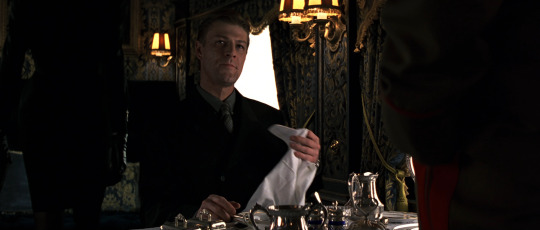
In the days when Janus used to travel all around Russia in his personal armoured train, the question of food always was a critical one. Of course, the on-board kitchen was well-stocked with quality tins, but one did not simply live on a diet of tinned food—especially when one was the immensely rich Janus.
Therefore, some of the Janus Syndicate’s enforcers were specially assigned to catering. They ordered dishes to the greatest chefs in all of Saint Petersburg and brought them back to base (not unlike a private Uber Eats…); they did the grocery shopping at the historical Gostiniy Dvor department store; they even procured rare and/or exotic ingredients from abroad. None of them complained—as long as they weren’t caught red-handed nabbing some of this exceptional food, the job certainly had its advantages.
Janus, as for him, didn’t complain either. As much as he despised his old friend James in those days, he had very much adopted the latter’s love for good, expensive cuisine for himself. While the local restaurateurs never saw him in person, he paid them so generously they came to look forward to the tough-looking henchman’s next visit. There were worse arrangements, especially in 1990s Russia.
What Janus also loved was history—above all else, Romanov history. In another life, he would have certainly been the dashing Count Vronskiy in Tolstoy’s Anna Karenina. Or, at the very least, a young, ambitious Don Cossack officer, relentlessly gaining power in the tsar’s court through intrigue and connections. But alas, he was born a century too late for that to ever happen. His consolation was to devour all the books he could find on the subject… and infiltrating the young Russian Federation’s politics to steer them away from Communism as much as he could.
It was while reading one of his history books that one day, Janus stumbled upon the story of Belgian chef Lucien Olivier and of his most famous creation—Olivier salad. Like every Russian, Janus knew the Soviet, cheapened-down variation of it, also known as Russian potato salad. He was very surprised to find out that the original was, in fact, very posh. Depending on the versions, it could include such ingredients as hazel grouse, crayfish tails, or even black caviar.
Intrigued, Janus kept searching about this historical salad. Chef Olivier had clung jealously to his recipe all the way to the grave, but fortunately some of his contemporaries had noted down their best approximations. The oldest possible source Janus could find was an 1894 article from the long-defunct magazine ‘Our Food’. For what he had in mind, it was a very good base.
So, one day, he summoned one of his caterers and asked for the recipe to be recreated, albeit with a few alterations of his own. The original recipe was forever lost after all, so no need for complete authenticity. Instead of hazel grouse, he wanted partridge—a very acceptable replacement, according to the 1894 article. If he did live the Cossack life, he’d probably have hunted it himself… but the truth was, partridge had been his favourite game meat ever since James made him try some.
Instead of crayfish, he wanted the sweeter, softer scampi. How English of him, one might say. Instead of meat jelly, he wanted the most buttery, decadent beluga caviar—hopefully not from Valentin Zukovsky's Azerbaijani farm, though. He wanted quail eggs, too. And for a slightly dark, smoked edge, he wanted French duck magret. Again, James’ influence on him might be stronger than he’d ever admit…
Lastly, there was the question of the most mysterious ingredient of them all—what the article called ‘Kabul’ sauce. Back in the day, it was a condiment made by the British firm Crosse & Blackwell, but it unsurprisingly had been discontinued eons prior. The replacement, Janus decided, would be a mixture of good old Worcestershire sauce and soy sauce. Russia had borders with China, Korea and Japan after all. Slightly spicy, with a umami kick to it… that resembled enough the descriptions he read.
The henchman finished noting this down, nodded, and went. Shortly before dinner time, he came back to the train with the customary bliny with sour cream and caviar… as well as this.
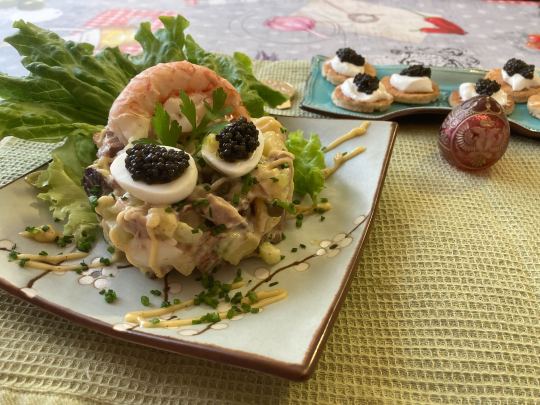
‘Delicious’, Janus thought at the first bite. ‘Well worthy of a tsar… I could call it the Janus salad.’
INGREDIENTS
(DISCLAIMER: the author broke the piggy bank for some of these ingredients because she made this dish for her 26th birthday. Do not feel obliged to do the same—that being said, scouring places such as Petrossian or La Grande Épicerie de Paris (a French equivalent to Harrod’s) was very fun.)
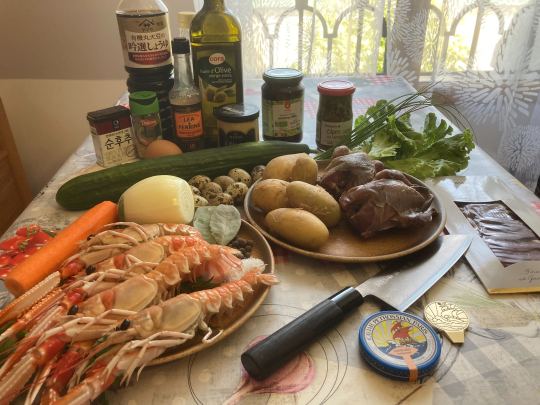
Salad (makes 3-4 servings):
2 roasted partridges (can be replaced with roasted chicken)
8 (+1, see decoration) quail eggs (can be replaced with chicken eggs)
5-6 waxy new potatoes (if you’re Janus, you’ll probably want Jersey Royals. If you’re a French frog like the author, Noirmoutiers are an excellent replacement.)
70g smoked duck magret (omit if you don’t have access to it)
Half an English cucumber
1 tbsp capers
10 black olives
Meat from the scampi claws
Scampi broth (if raw scampi are used):
Parsley
Tarragon
Dill
2 bay leaves
1 onion, quartered
1 carrot, chopped
Jamaican pepper (Bond would approve)
Coarse salt
Provençal sauce:
1 egg yolk
1 tsp Dijon mustard
2 tsp vinegar
olive oil (or olive oil + a neutral tasting oil—olive oil has a strong taste)
black pepper
garlic powder
2 tsp Worcestershire sauce
2-3 tsp soy sauce
For the decoration of 1 serving:
2 scampi (aka. langoustines)
1 lettuce leaf
The spare quail egg, halved
Chives
Black caviar (if you’ve got Janus’ unlimited funds, beluga is a must—since the author hasn’t, she used osetra instead. A good, much cheaper replacement with a similar taste would be trout roe... except it isn't as dark as Alec's soul 😆)
DIRECTIONS
Roast the partridge (or chicken) and let it cool down
Boil the potatoes and let them cool down
Boil the quail eggs for 3 minutes and let them cool down (8 minutes for chicken eggs)
Make the scampi broth. When it boils, add the raw scampi and cook for 8 minutes starting from when the broth boils again. Remove the pot from the stove and put it in a cold water bath. Leave the pot to cool down, so that the scampi are infused with the broth.
Remove the bones from the partridge/chicken, then chop it up into small pieces along with the potatoes, cucumber, magret, eggs and meat from the scampi claws. Add capers and sliced olives
Make the Provençal sauce. Mix the egg yolk and mustard then slowly add oil while whisking, until texture is firm (an electric hand mixer helps). Add the other ingredients and mix well.
Add two generous tablespoons of Provençal sauce to the salad, then gently mix it all up.
To serve, ideally use a ring mold. Decorate the molded salad with the scampi, egg, lettuce leaf, caviar and chives.
Serve very cold. The 1894 recipe says that it should be ideally done in ‘a crystal vase, like fruit macédoine’.
Приятного аппетита! (Bon appétit!)
SOURCES:
https://en.wikipedia.org/wiki/Olivier_salad (good overview)
https://liveuser.livejournal.com/77282.html (the 1894 recipe, in Russian)
https://stale.ru/en/different/olive-s-rakovymi-sheikami-gotovim-originalnye-salaty-olive-s/ (different variations of the original recipe with more complete instructions, Google (?) translated from Russian)
BONUS PICTURES:

Mmm roasted partridge
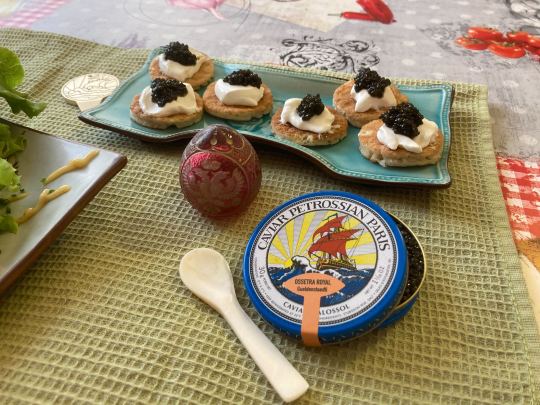
A good view on that caviar (I certainly am not going to get more any time soon, so gotta show off 😁). Also, six bliny of course.
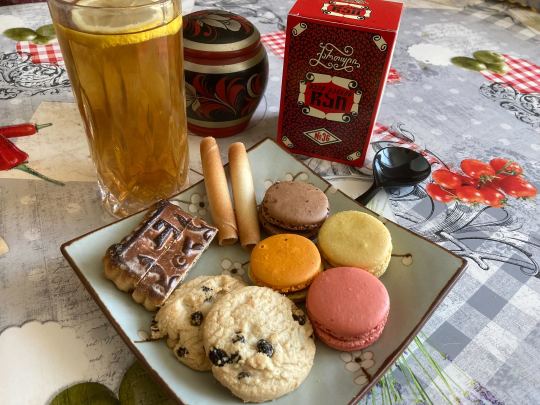
Little birthday dessert in the same spirit:
Georgian black tea with lemon
Chocolate, lemon, raspberry and mango macarons
‘Cigarettes russes’ (Russian cigarettes), which are Belgian rolled biscuits
Raisin and lemon Scottish shortbread
Apple and honey ‘tulskiy pryanik’, a sort of gingerbread from Tula, Russia
PS: did you spot the three Sean Bean non-Alec Easter eggs in the opening blurb? 👀
#007 Fest#007 Fest 2022#Team00#scavenger hunt#mi6caferecipes#james bond#007#goldeneye#alec trevelyan#breaking the bank#silverova showing off with her cooking#this was quite some work to make#but so fun#living the janus life#historical cooking#romanov era#olivier salad
36 notes
·
View notes
Text
Anonymous asked: I noticed you did post to acknowledge the death of Uderzo, the co-creator of the Asterix comics. I have to ask Tintin or Asterix? Which one do you prefer?
It’s like asking Stones or Beatles? I love both but for different reasons. I would hate to choose between the two.
Both Tintin and Asterix were the two halves of a comic dyad of my childhood. Whether it was India, China, Hong Kong, Japan, or the Middle East the one thing that threads my childhood experience of living in these countries was finding a quiet place in the home to get lost reading Asterix and Tintin.
Even when I was eventually carted off to boarding school back in England I took as many of my Tintin and Asterix comics books with me as I could. They became like underground black market currency to exchange with other girls for other things like food or chocolates sent by parents and other illicit things like alcohol. Having them and reading them was like having familiar friends close by to make you feel less lonely in new surroundings and survive the bear pit of other girls living together.
If you asked my parents - especially my father - he would say Tintin hands down. He has - and continues to have in his library at home - a huge collection of Tintin comic books in as many different language translations as possible. He’s still collecting translations of each of the Tintin books in the most obscure languages he can find. I have both all the Tintin comic books - but only in English and French translations, and the odd Norwegian one - as well as all the Asterix comic books (only in English and French).
Speaking for myself I would be torn to decide between the two. Each have their virtues and I appreciate them for different reasons.

Tintin was truly about adventure that spoke deeply to me. Tintin was always a good detective story that soon turned to a travel adventure. It has it all: technology, politics, science and history. Of course the art is more simpler, but it is also cleaner and translates the wondrous far-off locations beautifully and with a sense of awe that you don’t see in the Asterix books. Indeed Hergé was into film-noir and thriller movies, and the panels are almost like storyboards for The Maltese Falcon or African Queen.
The plot lines of Tintin are intriguing rather than overly clever but the gallery of characters are much deeper, more flawed and morally ambiguous. Take Captain Haddock I loved his pullover, his strangely large feet, his endless swearing and his inability to pass a bottle without emptying it. He combined bravery and helplessness in a manner I found irresistible.
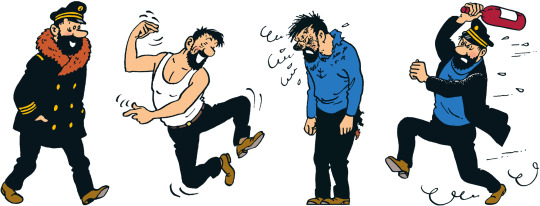
I’ve read that there is a deeply Freudian reading to the Tintin books. I think there is a good case for it. The Secret of the Unicorn and Red Rackham's Treasure are both about Captain Haddock's family. Haddock's ancestor, Sir Francis Haddock, is the illegitimate son of the French Sun King – and this mirrors what happened in Hergé's family, who liked to believe that his father was the illegitimate son of the Belgian king. This theme played out in so many of the books. In The Castafiore Emerald, the opera singer sings the jewel song from Faust, which is about a lowly woman banged up by a nobleman – and she sings it right in front of Sir Francis Haddock, with the captain blocking his ears. It's like the Finnegans Wake of the cartoon. Nothing happens - but everything happens.
Another great part is that the storylines continue on for several albums, allowing them to be more complex, instead of the more simplistic Asterix plot lines which are always wrapped up nicely at the end of each book.
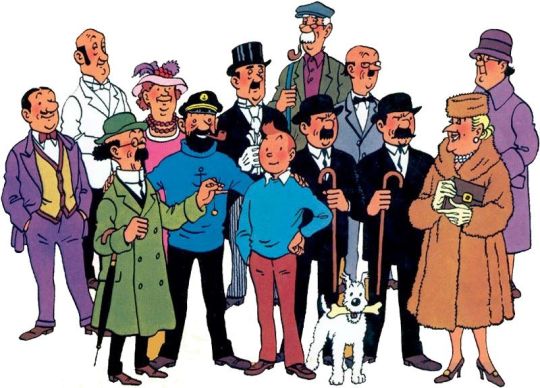
Overall I felt a great affinity with Tintin - his youthful innocence, wanting to solve problems, always resourceful, optimistic, and brave. Above all Tintin gave me wanderlust. Was there a place he and Milou (Snowy) didn’t go to? When they had covered the four corners of the world Tintin and Milou went to the moon for heaven’s sake!

What I loved about Asterix was the style, specifically Uderzo’s visual style. I liked Hergé’s clean style, the ligne claire of his pen, but Asterix was drawn as caricature: the big noses, the huge bellies, often being prodded by sausage-like fingers. This was more appealing to little children because they were more fun to marvel at.
In particular I liked was the way Uderzo’s style progressed with each comic book. The panels of Asterix the Gaul felt rudimentary compared to the later works and by the time Asterix and Cleopatra, the sixth book to be published, came out, you finally felt that this was what they ought to look like. It was an important lesson for a child to learn: that you could get better at what you did over time. Each book seemed to have its own palette and perhaps Uderzo’s best work is in Asterix in Spain.
I also feel Asterix doesn’t get enough credit for being more complex. Once you peel back the initial layers, Asterix has some great literal depth going on - puns and word play, the English translation names are all extremely clever, there are many hidden details in the superb art to explore that you will quite often miss when you initially read it and in a lot of the truly classic albums they are satirising a real life country/group/person/political system, usually in an incredibly clever and humorous way.
What I found especially appealing was that it was also a brilliant microcosm of many classical studies subjects - ancient Egypt, the Romans and Greek art - and is a good first step for young children wanting to explore that stuff before studying it at school.
What I discovered recently was that Uderzo was colour blind which explains why he much preferred the clear line to any hint of shade, and it was that that enabled his drawings to redefine antiquity so distinctively in his own terms. For decades after the death of René Goscinny in 1977, Uderzo provided a living link to the golden age of the greatest series of comic books ever written: Paul McCartney to Goscinny’s John Lennon. Uderzo, as the Asterix illustrator, was better able to continue the series after Goscinny’s death than Goscinny would have been had Uderzo had died first, and yet the later books were, so almost every fan agrees, not a patch on the originals: very much Wings to the Beatles. What elevated the cartoons, brilliant though they were, to the level of genius was the quality of the scripts that inspired them. Again and again, in illustration after illustration, the visual humour depends for its full force on the accompaniment provided by Goscinny’s jokes.
Here below is a great example:
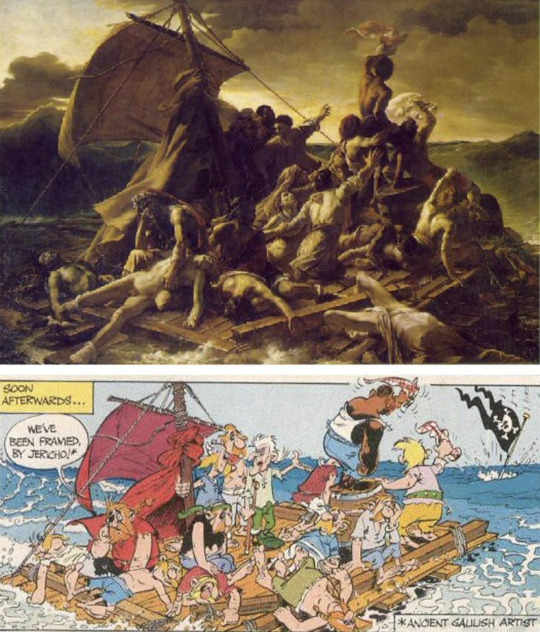
There’s a lot of genius in this. Uderzo copied Theodore Géricault’s iconic ‘Raft of the Medusa’ 1818 painting in ‘Asterix The Legionary’. The painting is generally regarded as an icon of Romanticism. It depicts an event whose human and political aspects greatly interested Géricault: the wreck of a French frigate, Medusa, off the coast of Senegal in 1816, with over 150 soldiers on board. But Anthea Bell’s translation of Goscinny’s text (including the pictorial and verbal pun ‘we’ve been framed, by Jericho’) is really extraordinary and captures the spirit of the Asterix cartoons perfectly.
This captures perfectly my sense of humour as it acknowledges the seriousness of life but finds humour in them through a sly cleverness and always with a open hearted joy. There is no question that if humour was the measuring yard stick then Asterix and not Tintin would win hands down.
It’s also a mistake to think that the world of Asterix was insular in comparison to the amazing countries Tintin had adventures. Asterix’s world is very much Europe.
Every nationality that Asterix encounters is gently satirised. No other post-war artistic duo offered Europeans a more universally popular portrait of themselves, perhaps, than did Goscinny and Uderzo. The stereotypes with which he made such affectionate play in his cartoons – the haughty Spaniard, the chocolate-loving Belgian, the stiff-upper-lipped Briton – seemed to be just what a continent left prostrate by war and nationalism were secretly craving. Many shrewd commentators believe that during the golden age when Goscinny was still alive to pen the scripts, that it was a fantasy on French resistance during occupation by Nazi Germany. Uderzo lived through the occupation and so there is truth in that. Perhaps this is why the Germans are the exceptions as they are treated unsympathetically in Asterix and the Goths, and why quite a few of the books turn on questions of loyalty and treachery.

Even the British are satirised with an affection that borders on love: the worst of the digs are about our appalling cuisine (everything is boiled, and served with mint sauce, and the beer is warm), but everything points to the Gauls’ and the Britons’ closeness. They have the same social structure, even down to having one village still holding out against the Romans; the crucial and extremely generous difference being that the Britons do not have a magic potion to help them fight. Instead they have tea, introduced to them by Getafix, via Asterix, which gives them so much of a psychological boost that it may as well have been the magic potion.

I re-read ‘Asterix in Britain’ (Astérix chez les Bretons) in the light of the 2016 Brexit referendum result and felt despaired that such a playful and respectful portrayal of this country was not reciprocated. Don’t get me wrong I voted for Brexit but I remain a staunch Europhile. It made me violently irritated to see many historically illiterate pro-Brexit oiks who mistakenly believed the EU and Europe were the same thing. They are not. One was originally a sincere band aid to heal and bring together two of the greatest warring powers in continental Europe that grotesquely grew into an unaccountable bureaucratic manager’s utopian wet dream, and the other is a cradle of Western achievement in culture, sciences and the arts that we are all heirs to.
What I loved about Asterix was that it cut across generations. As a young girl I often retreated into my imaginary world of Asterix where our family home had an imaginary timber fence and a dry moat to keep the world (or the Romans) out. I think this was partly because my parents were so busy as many friends and outsiders made demands on their time and they couldn’t say no or they were throwing lavish parties for their guests. Family time was sacred to us all but I felt especially miffed if our time got eaten away. Then, as I grew up, different levels of reading opened up to me apart from the humour in the names, the plays on words, and the illustrations. There is something about the notion of one tiny little village, where everybody knows each other, trying to hold off the dark forces of the rest of the world. Being the underdog, up against everyone, but with a sense of humour and having fun, really resonated with my child's eye view of the world.
The thing about both Asterix and Tintin books is that they are at heart adventure comics with many layers of detail and themes built into them. For children, Asterix books are the clear winner, as they have much better art and are more fantastical. Most of the bad characters in the books are not truly evil either and no-one ever dies, which appeals hugely to children. For older readers, Tintin has danger, deeper characters with deep political themes, bad guys with truly evil motives, and even deaths. It’s more rooted in the real world, so a young reader can visualise themselves as Tintin, travelling to these real life places and being a hero.
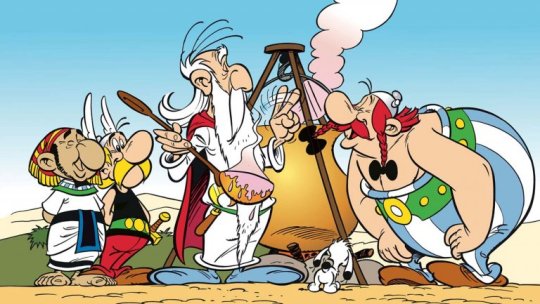
As I get older and re-read Asterix and Tintin from time to time I discover new things.
From Asterix, there is something about the notion of one tiny little village, where everybody knows each other, trying to hold off the dark forces of the rest of the world. Being the underdog, up against everyone, but with a sense of humour and having fun, really resonated with my child's eye view of the world. In my adult world it now makes me appreciate the value of family, friends, and community and even national identity. Even as globalisation and the rise of homogenous consumerism threatens to envelope the unique diversity of our cultures, like Asterix, we can defend to the death the cultural values that define us but not through isolation or by diminishing the respect due to other cultures and their cultural achievements.

From Tintin I got wanderlust. This fierce even urgent need to travel and explore the world was in part due to reading the adventures of Tintin. It was by living in such diverse cultures overseas and trying to get under the skin of those cultures by learning their languages and respecting their customs that I realised how much I valued my own heritage and traditions without diminishing anyone else.
So I’m sorry but I can’t choose one over the other, I need both Asterix and Tintin as a dyad to remind me that the importance of home and heritage is best done through travel and adventure elsewhere.
Thanks for your question.
297 notes
·
View notes
Text
Koi no Yokan
Before you read this, put on Kodaline’s All I Want while reading. Enjoy!
--------
pt. I [Hokkaido, first year]
It had been a while since Takumi felt close to someone.
Obviously, there was Isami-- they shared a womb, for Heaven’s sake. And then there was their childhood friend, Bianca, whom Takumi acknowledged the butterflies was for, but even then he knew she only had eyes for his twin brother.
But this-- this was different for him of how innocent and natural it started.
Soma was his rival, she was his rival’s friend. And she had been standing next to him ever since, watching the redhead from the distance. At least that was the initial thoughts until she’d planted a seed somewhere within him.
“Oh no, I don’t have enough money for this…” She frowned. “Let’s leave, Takumi-kun. I’m sorry it took so long.”
It was one of their days off during Regiment de Cuisine. The others were resting in their respective rooms, and both of them decided to take a little walk. She had asked him if he wanted to stop by the little scarf stall on the sidewalk, and he agreed to keep her company.
“Why, Tadokoro-san? It would be too cold if you decided to walk around without it.” He reminded her, “And it’s a pretty scarf.”
“I-I know, but… I don’t have all my money with me, so--”
“Then I’ll get this scarf for you.”
“O-Oh no, I can’t let you do that for me.” She waved both her hands.
“Would… you rather wear my scarf?”
“E-Eh?! T-Then you would be cold!”
Takumi smiled-- she had always been so selfless, “Then allow me. Consider it as a gift.”
He wasn’t bluffing when he said it was a pretty scarf-- a mustard yellow knitted warmth with a touch of glitter, and he didn’t hesitate to put it around her neck after he made the purchase.
It only dawned on him when their eyes meet. He saw a tint of blush on her cheek and it must’ve been his doing. Retracting his hands haphazardly was reflective.
“Oh, u-um… it does match your eyes, Tadokoro-san.”
"I-It does?" She asked.
"Si," The Italian nodded, "It glows even more right now."
His remark was followed by a sheepish smile, which then swoop in the shopkeeper who made a rather embarrassing assumption that they were somewhat of an item-- they both agreed it was awkward.
The ironic part was that the rest of their evening felt natural. Maybe it was the melon pan they shared after that hearty bowl of curry ramen-- the fact that it tasted sweeter to Takumi because Megumi had bitten into it before him, and this went on until the last crumb.
Could be the fortunate blizzard that suddenly happened when they take a stroll along the glimmering street. The cold wind could almost fly Megumi away that she needed to tuck her arm firmly in his.
Or it could be what felt the strangest the most to him-- when they decided to stop on an alleyway and she found his gloveless, freezing hands, she willingly cup his hands to blew a warm breeze on it.
"Is it better now?"
"Y-Yes," He stammered, "It really is."
When the blizzard was over, they walked back to their hotel hand-in-hand.
He knew her intention was to thaw his hand, but to Takumi, it was as if the seed she planted grew a few inches.
He walked her back to her room. She didn't forget to thank him for the scarf, and he expressed his gratitude towards her thoughtfulness at her door.
"Wait, Tadokoro-san." Takumi stopped her from entering her chamber.
"Yes?"
He looked into her once again. Golden eyes, braided hair that fell gracefully just below her shoulders, lips slightly pale from the cold, but the rosy color on her cheek stayed intact.
To him, she was beautiful.
"There's something I would like to say to you," He said. "But I'm gonna wait."
He tried to gauge the pause in her side, but before he could, she stuttered.
"E-Eh? Why? D-Did I do something wrong? Did I make you uncomfortable b-because I had to h-h-hold your hand?!"
"N-No, no. It's nothing like that!" He waved his hands.
"O-Oh, okay," She breathe a sigh of relief, "Then what is it, Takumi-kun?"
"I can't say it. Not yet."
"Why is that?"
"Because it’s complicated."
She blinked once, and then twice. But then she slowly, reluctantly nodded.
He fetched her a little smile, took another step closer to her before reaching for her hand.
He thought he heard her gasp slightly, but when he pressed his lips against her gloved hands, she didn't pull it away from him.
"Goodnight, Megumi-san."
As Takumi walked away from her room, he decided to look back. He was glad that she was still standing there.
//
pt. II [Tokyo, second year]
There were many moments where Takumi would love to pick things up where they left off that night in Hokkaido, but between their studies and Elite Ten businesses, he just wouldn't risk it for something immature.
That was the lie he told himself. If he was being truthful, it was because he knew her heart had been somewhere else.
//
pt. III [Venice, 2.5 years after graduation]
As faith would have it, they ran into each other in Venice, a couple of years after they had graduated.
Megumi had just told him she’d been through a terrible break-up with Soma. Not that she was still mourning over the lost relationship, but the solo trip she was taking was her process of self-healing.
Takumi listened over a cup of espresso, nodding along at how she was sadder to had lost her best friend rather than a boyfriend. He then told her he was in town with his Belgian girlfriend.
“Is she coming over soon?”
He shook his head at her question, “You know how up-and-coming actresses are. She’s been on set before I even woke up.”
“I-I don’t, actually.” She smiled apologetically, “Maybe you do since you’re a big celebrity chef.”
He scratched his head at that, “W-Well, I don’t mean it like that. I’m still the Takumi you’ve gotten to know in Totsuki.”
“Maybe you should come over there to surprise her, Takumi-kun.” She suggested.
“It’s not necessary, Tadokoro-san. I will see her tonight for dinner.” Takumi broke off a piece of his cookie, “If you don’t have any plans for the day, I would be happy to show you around. I know my way around since I've been here before.”
“Would it really be okay?”
“Of course,” He beamed, “Why wouldn’t it be?”
/
“Is that so? Alright. No, it’s completely fine. Yes, I actually ran into an old friend from Totsuki. Okay. Have fun on set tonight, okay? Bye.”
“Is that your girlfriend?” Megumi asked after he hung up the phone.
“Yes, she uh, had to cancel tonight.”
“O-Oh, I’m sorry.”
“Don’t be, Tadokoro-san.” His tone was reassuring, “So if you don’t mind, and since I will be free tonight, let’s have dinner at that ristorante you’re interested in.”
/
Takumi ended up spending most of his time in Venice with Megumi. Whenever he woke up and found the other side of the bed absent, he texted Megumi and asked if she wanted to go sightseeing. To his bliss, she never have said no.
To Megumi, having Takumi around a lot of times wasn’t something she planned, but even it surprised herself that she enjoyed his company. He’d taken her to best eating spots in town, explained a lot of building histories, even easily switched stories about their careers while they laughed about old high school habits.
But what surprised her even more was that absent, empty feeling whenever Takumi told her he’d be having lunch with his girlfriend, and how she had that sinking gut feeling that he must have missed his lady so much.
Takumi never told anyone that during that lunch, when his girlfriend was endlessly mumbling about her days on set, he’d zone out wondering what Megumi was doing.
/
That night when Megumi told him it was her last night in Venice, they decided to meet at Rialto Bridge.
“It’s so beautiful up here, Takumi-kun.” She said. “Thank you for always keeping me company on this trip.”
“Don’t mention it, Tadokoro-san. It is I who should thank you.” Takumi put his camera down after he captured the ever so majestic Grand Canal, “And I uh, apologize if I’ve been stealing all your free time.”
“O-Oh, not at all. You… actually saved me. From being alone.” She admitted, “When I decided to go to Venice alone to clear my mind, there is a… scary feeling that my thoughts of what happened recently would eat me alive, but thanks to you, it didn’t happen.”
Takumi smiled at her, “I don’t feel alone too.”
She returned the gesture with a beam, and he thought he feels his heart skipped a beat.
The lights might glimmer so gracefully along the banks of the Grand Canal, and what reflected on the water was even more idyllic with the gentle breeze of Venice night as dusk broke into a starry night.
That did not even compare to what stood next to him, glancing down at her long, blue hair as her slim fingers were tangled into it.
“Tadokoro-san.”
“Yes?”
Like each memory he’d made with her, he didn’t want to forget-- he wanted to treasure it. The seed she had planted many years ago was slowly blooming, and he couldn’t do anything to stop it.
“May I take your picture?”
/
It only felt natural to take her on a gondola ride just after she asked about it.
They’d been holding hands since Rialto Bridge. Not because one of them was cold or another one could be flown by the wind across town. This time, it was only them as two adults, savoring the moment within the gentle stream of water carrying their boat.
“Tadokoro-san,” He called her name, making her raised her head from his shoulder, “Do you remember a few years ago… when we were in Hokkaido for Regiment de Cuisine?”
“Yes, of course I do. You bought me a beautiful scarf.”
“Do you remember what I said at the door of your room that day?”
Looking down at their joint fingers, she answered, “Um… I think you said something about… wanting to say something, but you um, decided to wait. But I couldn’t remember it well since w-what you did after that made me nervous…”
At that, Takumi scratched his head, “O-Oh, w-well sorry about that. I didn’t know what--”
“Oh no, it’s alright, Takumi-kun. Isshiki-senpai later told me that it was an Italian thing, so…”
Sure, it was. “Oh, right, right. Yes, I did it because… Italian thing, yeah.”
Megumi nodded slowly, and then she blinked once before settling her gaze on him.
“Takumi-kun,” She said, “What did you want to say to me back then?”
Now, he knew she was not stupid. He knew she realized that it wasn’t really what an Italian would do to a friend.
“What I thought I felt that day.” He remarked shortly.
“Do you… still want to wait?”
“It’s a possibility,” He breathe closer, “What if instead I just… show you?”
She froze, “Um… how?”
“I’m not sure, Tadokoro-san.” He took the tip of her hair into his fingers. “What do you have in mind?”
Megumi gulped.
But in Takumi’s mind, the rippling sound of the canal in the warm evening air was the perfect serenade. The moment where he brought her hand close to his mouth once again and felt her smooth skin against his lips almost as if it was beyond his control. At that, her lips slightly part when he caressed her cheek, and gasped when he kisses the other.
And when the Bridge of Sighs was in sight, his lips walked a slow trail closer to her lips and paused on the edge to gauge her reaction. She had closed her eyes and he took it as a green light.
His lips met hers and everything made sense-- the curvy lines were aligned, the missing puzzle piece was found, and his questions were immediately answered. He knew this time why she felt warm on that winter night, and how natural it all was when he kissed her hand.
And now, years after that passed, she kissed him back in the place he’d never thought she’d even touch. One flick of her lips was all it took for his hand to travel to her blue hair and deepen the bliss.
It was the perfect kiss… well, almost.
“T-Takumi-kun, I-- we can’t do this…”
When she pulled herself back with a push of his chin, Takumi’s heart dropped-- he knew she’d say that, and he knew the reason why.
“Soma and I just split up, a-and you still have someone else right now, so I- I don’t think this is the right time.”
Yes, he knew she’d say that. “You’re right. I shouldn’t have-- I’m sorry.”
The rest of the gondola ride was filled with silence. Sitting a few inches apart and looking away were their only option since there wasn't much space to begin with. Takumi helped Megumi to get off the gondola with a pull of his hand, but then that was it.
He put his hand in his pocket and she used both of hers to hold her purse en route to her hotel. It wasn’t a cold night, but it was somewhat chilly now that a distance existed. He didn’t feel like talking, but then he caught her glancing at him with the corner of his eye.
Suddenly, his tracks were stopped.
“Takumi-kun, I-I’m so sorry…” She pleaded.
“I don’t think you need to apologize, Tadokoro-san.” He shrugged, “No means no, I get it.”
“You’re clearly not okay about it, and that makes me worried.”
Takumi huffed at her remark-- couldn’t she see it all? “And how am I supposed to be okay when I thought the girl I’ve been wanting since the first year of high school is finally wanting me back, only to be left with an impression that I’ve been reading your signals wrong?”
At this moment, he saw her golden eyes were glistening. It took all his strength to keep standing tall and watch her lips tremble, when all he’d been wanting to do was to make her pain go away.
“Have I been wrong?” This time, Takumi was the one pleading.
“I-- I don’t know…I-- I am sorry…”
A single tear rolled down her cheek, and he couldn’t watch her this time. Instead, he let out a sigh.
“Listen, I shouldn’t have said this, but you need to make up your mind somehow. I know what I want since that night in the scarf stall, and that is the selfless girl that was standing next to me. And if she couldn’t see that, I really can’t make her.”
At his confession, Megumi put her head down. He swore he could see another tears streamed down her cheek. This time though, Takumi lifted her chin and thumbed away her sadness.
“And frankly if one day you realize it wasn’t me, please don’t bother reaching out to me. I’ll always be certain that you are made for me, and it would kill me to see you with somebody else. I know that because it’s something I’ve gone through.” His voice was crooked, but still managed to point out to the corner, “Your hotel’s over there. Goodnight, Tadokoro-san.”
If this was their freshman year in Hokkaido, it would be different. He would look back and smiled when he saw her still gazing at him.
But this time, all Takumi did was walking still. Afraid if he looked back, the last image of Megumi he’d see is pain.
/
Later that night when the clock struck 3, Megumi was burying her tears under the pillow. Unsure of her own feelings that longed for him, but scared that she might hurt him.
At the same time, Takumi was confessing everything to his girlfriend, that eventually ended their relationship.
//
pt. IV [Sendai, the following month]
Megumi had tried to fight her feelings.
She knew even then Takumi was too good to be true-- someone who was kind, gentle, and so handsome that suddenly appeared before her eyes after a broken heart couldn't be real.
To her, love couldn't always be that perfect. Takumi was just there at her vulnerable moments, and if she was to let him into her life, he would be hurt when he found out her feeling turned out to be unreal.
She kept trying to find cracks and imperfections on what seemed to be a perfect foundation. Soul-searching that were done by meditation and evening prayers at the temple was to figure out if her heart really wanted him.
But what she knew ever since he left him in Venice was this: she couldn’t stop thinking about Takumi.
She had been on the lookout for signs-- signs that’d tell her it was him. That she should fly out to wherever he was in the world. But when it showed, her mind had a way to play tricks on her, telling her that these were just coincidences:
The mezzaluna she saw in the kitchen supplies store
A melon pan stall she spotted on the way home from the bookstore
The scarf he bought her-- she found it in her old closet after years
Came a moment when after a month of only seeing him by watching his Instagram activities, a gasp escaped when she found out Takumi’s in town for filming. She waited for days if he’d reach out to her first, before he announced on the platform that it was his last day in Sendai.
And then it clicked: she needed to stop overthinking.
That day, she had never left her packed Ryokan so soon, and had never pedaled her bike so fast in her life. Thanks to his current Story, she knew exactly which mochi place he was filming at.
Using her very last strength, she ignored the way her heart rushed because of her movement, or how a few drops of sweat had seeped into her turtleneck even though it was a cold day in autumn.
She had arrived just in time. Takumi was there-- so handsomely sporting a matching khaki trench coat and turtleneck with a lighter colored pants along with crews that surrounded him. They were recording him explaining a mochi’s characteristics with such charisma, and it didn’t look like he was going to notice her presence from a distance.
But he did.
Their eyes finally met, and she saw Takumi blinked a few times before he raised up slowly from where he was sitting.
“Oi, Takumi! What are you doing? We’re still rolling and--!”
“Can you guys please wait for just one moment?” He nonchalantly remark his yelling crew with a point of an index finger.
She had no idea how’d her face looked like when she saw him walking fast to where she stood, but she knew she’d miss him. So with that, she crashed her bike to the ground and started mimicking his movements.
Meeting in the middle were two previously aching souls. Breathless smiles were exchanged. Megumi touched her beating heart, and it was happy when she saw that sparkles in his ocean blue eyes.
“Tadokoro-san, you--”
She got on her tiptoes and sealed him with a kiss. A kiss so long-awaited that she swore she could stay like that for eternity. Only pressing each other’s lips without any rush, just calmness and solitude. It was simple, like all these supposed to be from the beginning.
When his hands travelled up her back, she realized love didn’t have to be so complicated. She wondered why she wasted so many years being drawn to a tangled yarn when a perfectly straight ribbon existed. The road that led her to him might be exhausting, but to her, he was worth it.
“Hello.” Takumi said as they pulled away.
“Hello to you too.” Megumi greeted, nurturing the space they shared. “So u-um… what were you going to tell me back then?”
“I'll let you know once I'm done filming, that if you decided to stick around this time.”
Megumi giggled, "Where else would I go, Takumi-kun?"
-o-
A/N: This fic is specially dedicated to my dearest friend @taku-megu (hi, I’m your secret santa ashfsfskgjslhs how exciting). I’m so happy to complete this work and to finally finish a fic that’s centered around takumegu with a happy end. I really really hope you like this story and I hope you’re having a wonderful time.
Special thanks to @shokugeki-secretsanta for hosting this event and giving me the chance and excuse to write something again for everyone!
So yeah, to the rest of you guys who are reading this, I hope you enjoyed this other piece of Akai Ito as much as I did writing it and have a very Merry Christmas to all of you!!
-MA
60 notes
·
View notes
Note
I decided to look this up! I don’t know about other English speakers, but from what I’m reading, we here in America call them French fries because of Thomas Jefferson, the third President of the United States, and a character played MARVELOUSLY by Daveed Diggs. Jefferson was big on foreign food, having fallen in love with French and European cuisine while he was the US Ambassador to the Kingdom of France during the Revolutionary War. In 1802, while he was President, Jefferson ordered his chef to make him “potatoes served in a French manner.” This was later shortened to “French fried potatoes” in a cookbook printed in 1852. This ended up being shortened to French fries. Of course, this explanation has been put under heavy scrutiny, and there are other stories, such as that of American soldiers stationed in Belgium being introduced to the fries during World War I. Given many Belgian soldiers spoke primarily French, the soldiers nicknamed them “French fries,” and it stuck. So, yeah! I think this is one of those things where it’s been so long that the story behind the term is lost, so only the term itself remains. It happens all the time, and I don’t think we’ll ever know why we English speakers call them French fries. It’ll always just be one of those things. Thanks for reading, and have a great night wherever you are! :)
Also what's with you inventing FRENCH fries???
English speakers called it that, not our fault Y'all r stupid
6 notes
·
View notes
Text
Celebrating Matt Bonney, Brouwer's Cafe and Bottleworks release the super limited Rolling Bones from Firestone Walker Brewing Company.
Not yet into the waning days of November, and already Brouwer's Cafe is planning for the final days of November by releasing an aperitif for what Brouwer's Cafe and Bottleworks have cooked up in the coming months. It begins with the limited distribution of Firestone Walker's Rolling Bones and continues with two unique beers from the Publican National Committee. But first, more on Rolling Bones from the mind of Jim Crooks, Masterblender at Firestone Walker Brewing's Barrelworks
Kindred brothers from another mother sit down together to blend and stutter. Mindful of much to do about nothing they paint with their palates; ideas get them buzzing. For years they held court beguiling like jesters, imbibing and jiving the ether of ancestors. They bring to the table a blend for the ages, the tricks of their trade they weave in like sages. From field to vat to barrel to bottle, bound flavors of feral to be read like a novel. The sounds of the bones that dance on the barrel head, relative memories for spirits not gone dead. Currants and plums and grape skins and Cuvee, Liefmans, Agrestic and Flander all in play. The game is a foot when the blend strikes a chord, still each in the group asks, "Is it me, Lord?" Found harmony though barrel and in friends past and present, the gift of this blend to bring joy, peace and presence. Sante!
-Jim Crooks, Masterblender at Firestone Walker Barrelworks.

image sourced from Firestone Walker Brewing company

image sourced from Firestone Walker Brewing company
Brewed and released at their taproom in Paso Robles, Firestone Walker is sending a limited number of cases and kegs throughout the country for enjoyment. For those who might view this as your run of the mill Brouwer's Cafe - Bottleworks tapping, this beer is so much more.
Back in March of this year (2019), the brewing industry lost someone special in Matt Bonney. Owner of the Seattle-chapter Toronado, as well as former Operations Manager at Brouwer's Cafe and Manager at Bottleworks, Matt Bonney, lived his life being generous to those who sought work, friendship, or just a pint. Soon after passing, friends and family gathered at his beloved Toronado before toasting him throughout the country in bars and exhibitions where his footsteps once fell. Even sadder, Matt along with other publicans, had planned to travel to Firestone Walker to brew what would have been the latest PNC (or the Publican National Committee) beer.
Years ago, while the PNC was still very active, they all got together to brew a handful of beers. They brewed a stout with Firestone Walker, and it was appropriately named PNC. A sour was brewed by Allagash and was named PNC #2 Broken Elevator. Wanting to honor these amazing beers, the former members of the PNC descended upon Paso Robles and had a conference at the Walker Farm. Together they crafted two beers that will hopefully be a lasting tribute.
It's worth noting that neither of these beers are ready. This, of course, hasn't impeded Brouwer's Cafe and Bottleworks from honoring both the living the dead this Thanksgiving with little help from Firestone Walker. On Wednesday the 27th, as you run your Thanksgiving Day errands, Brouwer's Cafe asks you to stop in and raise a pint to Matt Bonney, raise a pint to a publican that is forever missed.
Brouwer’s Cafe is located at 400 North 35th Street in Seattle’s Fremont neighborhood. For more information, including food and events, visit https://www.brouwerscafe.com/
About Brouwer’s Cafe
We have 64 craft beers on draft, a selection of over 400 bottles from both the U.S. and abroad, an exceptional selection of Scotch and American Whisk(e)ys and a full service bar, and Belgian-inspired cuisine.
Our Belgian-inspired cuisine includes our versions of Belgian classics such as pommes frites (true Belgian fried potatoes), stoofvlees (a thick Belgian stew served on Frites), and the Belgian staple of moules-frites. We also serve a variety of sandwiches, such as our very popular lamb burger, which is ground in house. We also have a selection of salads, desserts, and a rotating specials menu.
We serve Seattle's Fremont neighborhood seven days a week, opening at 11 am. Our "Power Hour" is from 3 pm to 6 pm everyday and boasts a delicious selection of small plates and $1 off all draft beers and well cocktails.
from Northwest Beer Guide - News - The Northwest Beer Guide http://bit.ly/2QtNJFR
1 note
·
View note
Text
Warm Flanders
Indulging our traveling desire and continuing the newly developed tradition of European Christmas markets, we bought tickets to Belgium. This trip had its peculiarities - and a unique aftertaste. Welcome to the capital of Europe!

Panorama of Bruges from Belfry (I assume, the point where Brendan Gleeson's character jumps off in the movie 'In Bruges'
I don't know how we chose Belgium - but it all started with just Brussels, and then grew to another three towns. I suspect we may have a psychological condition.
After Brussels, Bruges was an obvious addition to the trip. Possibly the most well-known of tourist destinations in Belgium, it features a well-preserved medieval town so quaint like it crawled out of a fairy tale.
The movie 'In Bruges' (a nice piece of popularized arthaus) added to the fame of the place. The town in this flick is a character of its own - it serves as the premise and the plot twist, it helps to make hard choices and aids the protagonist. Besides, the film has gorgeous cast. Seriously, look it up if you've never seen it - or rewatch if you have.
Being in Belgium (and, more importantly, its northern part, Flanders - probably the most history-heavy region), I absolutely had to see Antwerp. Ghent was a curious little addition that we didn't plan - but that happened between Bruges and Antwerp just because we had time and opportunity. Stay tuned for more.
Brussels: Art and Chocolate

Rue de la Chaufferette/Lollepotstraat, LGBTQ art street in the inner City of Brussels
Brussels is a weird city. Commonly I enjoy places that don't mind you roaming the streets (think Rome, Bangkok, New York). Brussels is however different. It etched into my memory as grey and rainy (I barely got a chance to snap a photo), and multifaceted to the point of utter incomprehensibility.
That is partly on national communities. Our free-tour guide mused on the immigration agenda of the city: nearly 80% of the current population (first and second generations) are not native to Belgium. The city, being the administrative and political center of Europe, is the very definition of a cultural melting pot.
Only a day before we arrived, French workers had a strike against ever-growing prices - thus all of Brussels was covered in barricades (not sure about the name, but something like Cheval de frise or knife-rest (aka Spanish rider) obstacles; all cold metal and barbwire, brutal).
But Brussels also flaunts its historic heritage and celebrates its art. The whole city is covered in street art - most notably scenes and characters from comics and statements in favor of LGBTQ community. Street decorations and overhead lamps of different designs and splendor turn the city into an exhibition of light.

Altmejd, 2015. Musees royaux des Beaux-Arts de Belgique/Koninklijke Musea voor Schone Kunsten van Belgie
The more traditional artistry is spread within the cluster of museums of Mont des Arts/Kunstberg, most notably the Royal Museu of Fine Arts that features both old masters (David, Rembrandt, Rubens - and a whole hall and Google-partnered tour program dedicated to Bruegel) and new masters (some of my beloved Impressionists including Van Gogh, Serat, Gaugin, and a couple of Rodins). Another pearl, Magritte's museum is just down the stairs.
We've also followed one of the most bizarre quests I've ever had, looking for all three pissing monuments of Brussels - the symbol-status Manneken Pis, his female version Jeanneke Pis and a non-fountain canine variation Het Zinneke. Belgian people are weird.
We had some hysterical fun trying to decipher one of the ads on a bus stop. It claimed certain Subea was the best gift for your loved ones on Christmas. Passersby undoubtedly believed us crazy as we tried to identify the thing - and never came close to guessing. Look it up, it's hilarious.

Blue street art, Brussels
Built on the time-tested principles of trading cities, Brussels preserves the tradition of market squares. In early December, the downtown is covered in Christmas towns and motley crowds, framed in softly shimmering lights. It's full of flavors of waffles with cream, and frites, and gluhwein, and seafood, and sausages.
Brussels is full of cyclists (even more so than Copenhagen), full of churches, and homeless, and nationalities - cuisines, skin tones, languages. The signs duplicated in French and Dutch do not help location purposes in any significant way.
Nevermind the confusing feelings I developed for Brussels, there is one thing I should mention with firm praise - chocolate. Walk the streets and have a cup of hot chocolate - it's literally chocolate of your choice melted in hot milk. Eat warm Liege waffles topped with chocolate and cream. Buy a set of (regular) chocolate boxes with discount - or pay a visit to Galeries Royales Saint-Hubert to learn about chocolate as art. It's expensive, yes, but oh is it worth every cent!
Break a chocolate bar of preference - dark works best - into pieces, add to the cup and pour with hot milk. Stir until it melts. Enjoy the taste of Belgium.
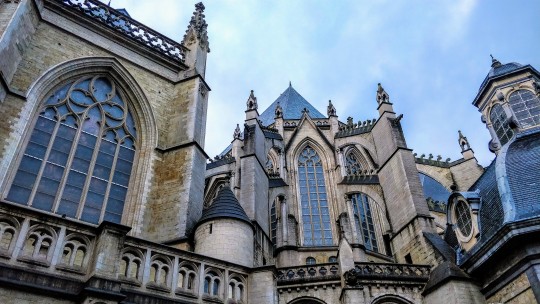
St Michael and Gudula Cathedral, Brussels
What to see in Brussels:
Grand Place
Brussels Town Hall
Residence of the Dukes of Brabant
Maison du Roi/Broodhuis
Manneken Pis
Jeanneke Pis
Het Zinneke
Bourse/Beurs (stock exchange)
Galleries Royales Saint-Hubert
St Michael and Gudula Cathedral
chapelle de la Madeleine/Magdalenakapel
Mont des Arts/Kunstberg
Musees royaux des Beaux-Arts de Belgique/Koninklijke Musea voor Schone Kunsten van Belgie (Musee Oldmasters, Musee Magritte, musical instruments museum)
Royal Palace
Parc de Bruxelles/Warandepark
eglise Notre-Dame au Sablon/Onze-Lieve-Vrouw ten Zavelkerk
eglise royale Sainte-Marie/Koninklijke Sint-Mariakerk
National Basilica of the Sacred Heart
Atomium
Royal Palace of Laeken
Bruges: The Belfry and the Waffle Houses

Rozenhoedkaai, Bruges
Belgian capital is the least Flemish city among those I've visited. Bruges, on the other hand, seems to bear the imprint of one of the richest regions of medieval Europe. The town is neat and cute, full of waffle houses with stair-step facades, all red brick and yellowish stone. The streets are carefully crafted and well-groomed; they stretch in slow curves, and the houses crowding each side chant their stories to the tourists in a never-ending lullaby.
Houses plaster all over each other - it feels like each street has only one building that was actually constructed with 4 walls. The rest figured 'hey, here's a perfectly good empty wall right there, with nothing attached, why not stick to the side'.
The whole country is like that, one of the signature traits of Belgium, alongside angry cyclists and painted waffle houses.
Before walking to the main attraction (Belfry, naturally), we've decided to have a glass of beer in Halve Maan, one of the oldest breweries in town. We were pleasantly surprised by the sleepy emptiness, the fireside couches and craft beer (I've never had an 11° beer before, it felt almost as a shot of whiskey). In a slumbery, sheepish haze we walked around the Minnewaterpark with its swans and gardens dipped in green moisture.
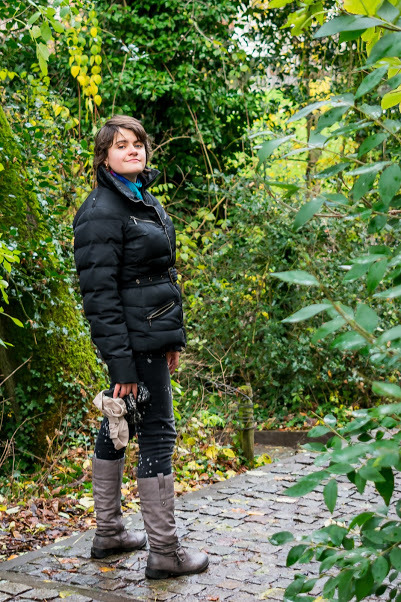
Minnewaterpark. After the rainy, grey-ish Brussels, Bruges met us with sun-through-the-clouds and warmth worthy of mid-October. I finally got out my camera and snapped my way through the cute medieval city
The territory of Bruges is covered in canals - no wonder it's called the small Venice of the North, and the centuries-old architecture covers the town in a romantic blur. Even the long queues of Belfry (one person in, one out, and around half a hundred waiting for their turn) didn't disturb our dreamy mood. The view from above maps the whole town on the palm of your hands, and the stone parapet is covered in numbers and names of cities with arrows pointing the direction.

Carillon, a fascinating musical instrument that has several dozen bells connected to play melodies. The Belfry carillon plays a different melody every quarter of an hour
Belfry is gorgeous at sunset, especially observed from Grote Markt - towering, starkly contrasted against the fading skies.
Bruges is probably best-known for its streets - after you've seen the main attractions, there's no clear itinerary, but just wander around and get lost in the medieval brick labyrinth. You can visit the old windmills - each with its own unique name - and the corner of Groenerei, which is less romantic in winter but still a nice place for a romantic rendezvous. Or just roam the streets and inhale the ambiance of this old town that looks like it jumped straight out of a fairytale with enchanted castles, simplistic plotline where good always conquers evil and a set of enjoyably cardboard characters.
Sometimes it's fun to experience something so far from real life. Can't disagree with the philosophic view of Fiennes's character from 'In Bruges'.

What to see in Bruges:
Kasteel de la Faille
Sashuis
Minnewaterpark
Sint-Janshospitaal-Memlingmuseum
St Salvator's cathedral
Church of Our Lady (featuring Michelangelo's Madonna met Kind)
Bonifaciusbrug
the Four Horsemen of the Apocalypse
Rozenhoedkaai (the most photographed spot in Bruges)
't Brugse Vrije
City Hall
Basilique du Saint-Sang
Brugge markt
Belfry and Market Halls
Provinciaal Hof
Jan Breydel en pieter de Coeninck memorial
St James's church
Jan Van Eyck memorial
windmills (de Coelewey, de Nieuwe Papegaai, Sint Janshuismolen, Bonne Chiere)
Sint-Annakerk
Gronerei
Train Tales
Belgium is unexpectedly bad at doing trains. We heard the first bell as we tried to get out of Brussels. The Northern train station has a clear division between two worlds. The ground floor belongs to hobos and (most probably) unemployed immigrants - this is the world of half-light, scary coughs and little noises, empty food wrappings, garbage, people wrapped in multiple layers of dirty blankets and coats. The upper floors are obviously European, well-lit, with shops, 24/7 information desks and wending machines. The contrast is so stark that it's frightening.

(Under)ground floors of Antwerpen-Centraal
Yet this was but a warning. For some unknown reason, the schedule of Belgian trains is really complicated - we couldn't make sense of it using just timetables and scoreboards. This was a shock for me specifically - I just went to Italy a month prior, where I didn't even need to talk to anyone to understand where to buy tickets and how to get from point A to point B.
Obviously we were not alone confused by the whole system - by the machine selling tickets, a nice lady was spending her working hours explaining stupid tourists how this works. She offered us a ticket we didn't consider - it could take us to 10 destinations (we needed 6, and decided to spend 2 more for a short detour to Ghent before Antwerp; profit).
The complications started when we failed to notice the class of the coach we were boarding. Truth to be told, there was a number '1' on the side - but the inside didn't look any different from second class, so I'm not sure what's the deal. 10 minutes into the ride, a railway employee walked in and aggressively started to demand extra payment to 'upgrade' our tickets - about 10 euro per person. None of us were allowed to leave the first class coach for the second.
The thing about that whole situation was: of all the people in the coach, only one woman was aware of its first class status. The rest were bewildered and looked like lost tourists (some of us surely were) who forgot to check the number on the side of the carriage. Which, frankly, didn't feel like the people's fault. A Spanish family nearly started a brawl with the guy - which earned my compassion but also a portion of solid mirth.
Hilarious experience - but also quite frustrating. Not too fond of Belgian train system.
Ghent: The Castle and the Histrionic Weather
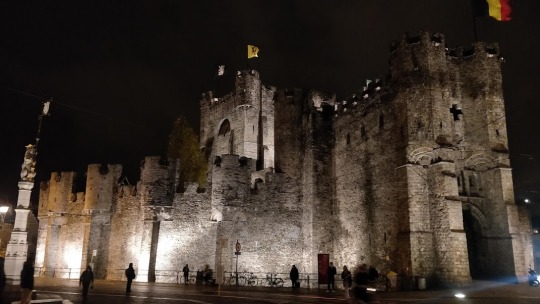
Gravensteen, Ghent
I didn't expect this short detour would turn out this satisfying. Don't get me wrong, there's not much to do in Ghent in the evening. In a manner traditional for the whole country, life dies away after 6PM. As nightfall covers the streets, the shops and restaurants close, and the whole city seems deserted. There are some late passersby, some groups of youth and random tourists but they're not common, especially further from downtown.
But the architecture is spectacular nonetheless. Korenmarkt (basically, central square) with Church of Saint Nicholas is the heart of the city. The sites are mostly all on the same line - Stadhuis Gent and Belfort, Saint Bavo cathedral and a couple of nearby 'palaces' that were actually residences of (very) wealthy merchants, and Saint Michael's church on the other side of Korenmarkt, across the Leie river.

It was enjoyable to just wander the empty streets quite aimlessly, bumping into architectural sites curious things here and there
Gravensteen is exactly the prototype you imagine when someone says 'a castle'. It's the type of medieval structure you drew as a kid, with the battlements and turrets. This is where a valiant knight came to rescue a fair maiden from an evil king. It's The Ultimate Castle.
In yet another plot twist, the weather in Ghent was unpredictably fun. It made us giggle at its hysterical fits.
Rain, wind and damp autumnal warmth changed each other in bizarre epileptic seizures.
One moment, it decided to rain - and the downpour started as soon as we opened our umbrellas. 2 minutes later it all stopped as if nothing happened. Ten minutes passed - and terrible gusts of wind that nearly knocked us down. Sure enough, soon it was warm and mellow again. Best advice when the weather is in such a theatrical mood: keep an umbrella with you at all times.
The walk from the city center to the train station is quite long, about an hour. But at least the building of the train station is worth exploring - it has great inner decorations all over the ceiling that imitate medieval style. Outside, by the largest bike parking I've seen after Copenhagen's sleeping districts, a sad man was playing his wistful sax; there seems to be something about Belgium and saxophones.
What to see in Ghent:
Korenmarkt (basically, central square)
Church of Saint Nicholas
Saint Michael's church
Gravensteen
Stadhuis Gent
Belfort
Saint Bavo cathedral
Antwerp: The Train Station and the Sky
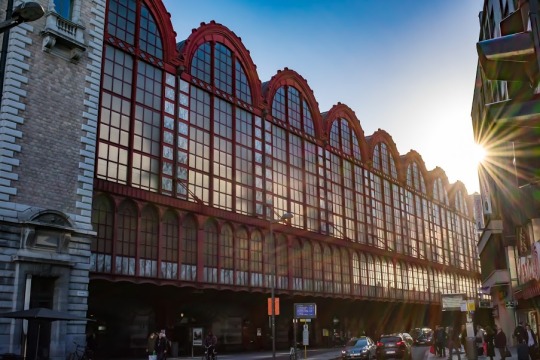
Antwerpen-Centraal Train Station, Antwerp
After the grey cold rain of Brussels and the crazy run of tourist-packed Bruges and (devastatingly) empty Ghent, Antwerp was all sunshine and warmth. Easily the most enjoyable time I've had in Belgium.
Antwerp is a mild, soft city, quite self-indulgent - it has less tourists than either Brussels or Bruges - and completely immersed in its own thoughts. Traces of the eternal, undying energy that preserves big cities can be found everywhere.
First things first, we went to see the jewel of Antwerp's sightseeing itinerary - Antwerpen-Centraal, the main train station of the city. It has 4 floors, with trains arriving on each of them - it is really impressive, especially as the whole structure is sunlit through the ribbed glass roof and the underground floors are dipped in orange-and-purple lights, the true impressionist study of light and color.

Antwerp has a clear itinerary, as if the city was built with the idea of easy navigation in mind. Starting from Antwerpen-Centraal and past the diamond district, the shopping streets of Antwerp start and run right to the heart of the city, Grote Markt. The walk there is short if one ignores the detour sites like the beautiful neoclassical Bourla theater with round-ish colonnade façade, the house of Rubens turned museum, the oldest house in Antwerp build circa 1480, completely wooden and still inhabited, or the baroque St Charles Borromeo church, which simplistic interior is decorated with astonishing woodwork.
The notorious diamond district of Antwerp is located right beside the train station. History has it that it all started with shops opening here so that rich people coming to Antwerp to buy diamonds could keep their incognito and leave as soon as the deal was sealed, without the need to visit the town.

Grote Markt and the nearby Groenplaats are connected with a short street that features another pearl of Antwerp, the Cathedral of Our Lady. This majestic Gothic temple is narrowly surrounded by the old houses of trading guilds glued to its every side. You cannot actually see the side walls of the Cathedral (which is another trademark feature of Flemish towns - a dead giveaway that trade was of utmost importance, and that secular and religious matters were closely connected).
Grote Markt itself looks just like other main squares in Belgium - a lot of space adapted for Christmas markets during this time of year, crowded by waffle houses with gilded statues and inscriptions dating back to the Autumn of the Middle Ages, and towering Brabantine Gothic spire, the cynosure of the city.

Stroh violin player. Stroviol is a popular instrument of street musicians, seen all over Flanders
The next thing I was agitated to see was Sint-Annatunnel - a 1/2 km tunnel under the riverbed, fully built for walking on foot, riding on bicycles and even for motorized vehicles. The escalators are wood-paneled and lacquered, the photos on the walls tell the history of construction of the tunnel as one descends.

Quay along river Scheldt, shipyard and windmills
On our way to MAS, we've taken a turn into the Antwerp red lights district. As I was quite shamelessly staring at the girls (literally) displayed in the windows, my friend surprised me, hilariously paying attention to some nesting boxes on a random tree instead. Some way to explore the city.
Don't miss on the chance to visit MAS museum. For a tourist, it's a golden opportunity: free entrance to the rooftop with stunning night panorama of Antwerp lights. From up above, the lights on the windmills twinkle red, painting an ominous image in the night skies. The walls of the interior are covered with posters of modern art (sometimes inspiring, sometimes hilarious, sometimes frightening). Besides, MAS is open till 10 PM, a rare case for Belgium.
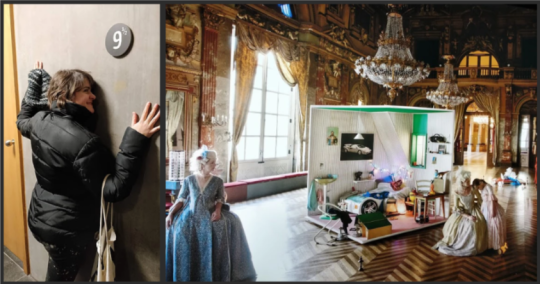
MAS pays the oddest homages, and one of them is to Harry Potter franchise: the building features floor 9 and 1/2.
While on the roof of MAS, the pragmatism and commercial genes of Flemish people deliver nothing but pure delight. The nearby houses host advertisements for the visitors of the museum: cafes and restaurants ornament their awnings with offers of hot drinks and rich meals.
What to see in Antwerp:
Antwerpen-Centraal
diamond block
Leysstraat 32-34 and 27 (twin buildings)
Meir (shopping street)
Rubenshuis
Bourlaschouwburg
Boerentoren
Sint-Carolus Borromeuskerk
Groenplaats
Cathedral of Our Lady
Grote Markt
Brabo fountain
Stadhuis Antwerpen
Het Steen and Lange Wapper memorial
Sint-Annatunnel
Stoelstraat 11 (the oldest house of Antwerp)
Sint-Pauluskerk
Schipperskwartier (red lights district)
MAS museum (rooftop viewpoint)
What to eat:
chocolate (in all forms, whether it's box of finest pralines, a chocolate bar, or a cup of hot chocolate)
waffles (fillings vary; I personally prefer dark chocolate and whipped cream. Belgian people however have plain waffle with sugar powder)
beer (one of the oldest and most important produces of the region; brewing beer is fine art here)
frites (basically French fries, but don't call them that - it's offensive, given the fact they were not invented in France; the locals still hold their grudge over the matter)
mussels (Brussels specialty, usually go with frites on the side)
Flanders As It Is

Wandelterras Noord, quay of Antwerp, near Sint-Annatunnel. The sun gave us its last warmth of the day as we strolled along the Antwerp quay, the dark silhouettes of seagulls scattering sunbeams as we scared them off the railings
The towns of Flanders are easily recognizable. The main square is always called 'Grote Markt'; the combination of a cathedral (usually of Our Lady), a stadhuis and a belfry impending over the town is mandatory. Old houses of stone (and sometimes even wood), with stepped roofs and intricate ornaments. Waffles and chocolate on every corner, infinite varieties of beer in any pub. Add cyclists during the day or bicycle parking at night, cobblestone streets, a culture co-depending with trade - and you have a perfect portrait of a Flemish city.
It was a little vacation we all need from time to time - not spectacular but fun, warm and surprisingly full of color in this grim, gray time of the year.
2 notes
·
View notes
Photo
Here’s the full article.
Okay, so I checked some dates and I’m coming late to this party without even a tub of tuna-jello-mayo salad to offer, but it’s a hoot. And though it’s not a parody or satire (at least I’m pretty sure it’s not; if it is, then it’s amazingly subtle) this dramatic reading will have you cackling.
youtube
T. B. Skyen is a tonic.
Seriously, if you’re feeling a bit low, give it a listen (with headphones because of the F-word a few times, even though that includes quoting the article itself). His lost-it-completely reaction to “NATURALLY, she loathes mayonnaise” will have you on the floor, but in a good way - that laughter is really infectious!
However writer Hingston - is she foaming at the mouth or are those flecks of mayo? - has a lurking xenophobic nastiness like a slice of time-expired chicken sealed in tomato aspic, and it’s one of the reasons why I can’t persuade myself that the piece is deliberate satire.
How dare foreigners have foreign food that wholesome young Americans are taking interest in?
Being born in 1956 should have me in the age-group that nods agreement, yet not being born in the US makes me look at the phrase “most American of foodstuffs” and go "meh” - do people still go “meh”? - because it’s French.
Or possibly Spanish. But not American.
Call it mehonnaise if you like, because originally it was probably Mahónnaise.
*****
And I hate (oh, who am I kidding?) to break it to her but aïoli / alioli isn’t mayonnaise any more than passata is ketchup.

Here’s another example: two kinds of Racing from Doncaster...


...with more similarity than mayo and aïoli.
So much red-hot outrage about a cold bland sauce, when it seems to me more like “They don’t like my antediluvian potato salad, they’ve never liked it, and now they’re not eating it, WAAAAH!”
(cue Lucille Ball...)

Antediluvian? Well, she thinks her mother’s jellied salad, made with black cherry Jell-O, walnuts, olives, canned cherries and small balls of cream cheese is “dynamite”.
Bless her little heart.
Maybe in 1960, though since it probably looked something like this, maybe never.

That photo should come pre-packed with the ominous low-level humming, buzzing noise Hollywood uses for “dangerously radioactive”.
Or the sound of low, stealthy breathing.
And before leaving the topic of Jell-O, let’s try some fusion cuisine as it was done Back Then...

You’re welcome.
*****
A thought: if mayo is the most American of foodstuffs, why do American tourists in Belgium and the Netherlands not want it on their French fries as a taste of home in decadent foreign Europe?
A bunch of years ago, @dduane and I were near the frietkot near the Belfry in Brugge’s Markt (a pity this pic can’t be enlarged enough to read the window menu)...

...and heard a gaggle of Merkin tourists not want it.
They weren’t teens but people of about our age, old enough to have good manners or at least not giggle and clutch each other while going “eww” and “gack”, went on about it loudly and at length as if just saying “no mayo, thanks” wasn’t sufficient.
And then they went on just as loudly among themselves (unaware - or not caring? - that the Dutch and Belgians speak and understand English very well) about how weird it was to put mayo on fries, as if the food habits of a foreign country were done deliberately to annoy them...
Ho hum. All the more for us! Lekker!

It’s not like they were stuck with just Hellman’s, either: there’s curry mayo, black pepper mayo, ketchup mayo, garlic mayo, tartare mayo, frietsauce, saté sauce, Sauce Americane (mayo, tomato, chervil, onions, capers, celery salt)...

...Sauce Andalouse (mayo, peppers, tomato, pickles), Sauce Brazilienne (mayo, pureed pineapple, tomato, spices), Sauce Mammoet (mayo, tomato, onion, garlic, soy sauce), Sauce Samourai (mayo, harissa, spices, tomato, peppers...
And some places even have a sauce based on stoofvlees / stoverij (that’s carbonnade / beef stew with beer to you and me) which turns a cone of fries into something very satisfying indeed...

(Cripes, I had a good lunch and despite the jello pics I’m hungry again...)
The frietkot had a fair selection, so there must have been a mayo they’d have liked somewhere.
Or maybe, if it actually tasted of something, it wouldn’t be what they - or Sandy Hingston - would regard as “American mayo” any more.
:->


what the fuck is this article
98K notes
·
View notes
Text
Travel Blog Post #19: 26/07/18
Hallo!
I cannot believe how fast time flies! It feels like just yesterday that I stepped out of Amsterdam Airport Schiphol and began my four-week adventure in the Low Countries. When I first learned about this study abroad program over winter break earlier this year, it seemed as no more than another one of hundreds of summer opportunities I could partake in while away from Berkeley. Learning that this study abroad course could also satisfy the Arts and Literature Breadth required for graduation from the College of Letters and Science only peaked my interest more. However, what truly pushed me into enrolling in the program was an insatiable desire to travel, explore the world, and hopefully learn something along the way! Prior to participating in this course, I knew relatively little about the Low Countries besides their representations in pop culture. For example, a mentioning of the Netherlands immediately brought to mind quaint images of agricultural life, peaceful windmills, and a plethora of bicycles! Of course, one also thinks of incredibly liberal values and tolerance when discussing the Netherlands. Furthermore, my thoughts on Belgium could be summarized in the following four words: chocolates, waffles, fries, and beer! Although I was able on several occasions to satisfy my interests in the aforementioned clichés, such instances were more the exceptions rather than the rules when it came to the Low Countries.
To begin with, since the study abroad program began in the Netherlands, my first exposure to the realities of the Low Countries began there. Beyond bikes and canals, I increasingly began to realize the true complexity of this rather small Western European nation. In addition to exploring the American perception of the Netherlands that I was already quite familiar with, I also discovered the Dutch perception of the United States through several conversations with locals. For instance, I learned about how opinionated yet conventional Dutch people can be in everyday life. Moreover, I also discovered the limits of the Netherlands’ famous reputation for tolerance following news of debates among Dutch lawmakers to make the covering of the entire face against the law. Such legislation is clearly aimed towards the Netherlands’ Muslim population, especially within the context of the string of terror attacks that have taken place across Western Europe in recent years. Even though I found the tremendous amount of Dutch art, culture, and history that I encountered to be incredibly interesting, discussing contemporary issues (like the one mentioned above) within a global context has left the largest impact on me after exploring both the Netherlands and Belgium.
Second, I was extremely elated to see that popular clichés surrounding Belgian chocolates, waffles, fries, and beer remained entirely accurate! At this point, I have largely lost count of the amount of gluttonous foods I have consumed over the course of the two weeks the program spent in Belgium. However, aside from the joys of Belgian cuisine, I was particularly fascinated by how noticeably different the Dutch and Flemish were from one another, despite their common language. For example, in comparison to the more structured and organized Dutch, the Flemish behaved in a more relaxed manner that I would expect to see among the populace of most Southern European countries. In addition, the devoutly Catholic Flemish pursue religion differently from the Protestant and perhaps more secular Dutch, according to my own observations.
Nevertheless, visiting both nations has been a tremendous pleasure for me and I look forward to the day I return, hopefully with a visit to the third Benelux country: Luxembourg!
Until then, tot ziens!
youtube
1 note
·
View note
Photo

Volcanic Explosion
- Oh no! What a disaster! There is hot chocolate everywhere, even in the grooves of the dishwasher. - It is necessary to clean immediately, otherwise the milk will rot. With that, Bixente went to get the Spanish mop and sponges. Bachué went to the living-room to warn his friends. As she burst out laughing, she recounted how she had stirred too much chocolate and how the foam had risen and how the case had ended in a volcanic eruption on the washing machine. Oh yes! The kitchen was tiny and the top of the machine served as a worktop. Chuckling with laughter, she added: - We'll have to leave you, because the longer we wait, the harder it will be to clean up. - Chocolate is everywhere, everywhere! Bixente commented jovially. Explosion of hot chocolate! What a story! The guests stayed in the living room because the kitchen was too small for them to be of any help. Bachué and Bixente sponged, sponged and mopped again, but it seemed that there was always one more place to discover and that it was necessary to clean up. It took a lot longer than they would have imagined. - A Basque and a Colombian, unable to prepare chocolate ... Traditions are getting lost it seems. - No, it's at least the hundredth time that we enjoy this recipe. Even the best cooks can be wrong at least once in a hundred. - You call it wrong, it's a real disaster! And what will our friends think? - They'll think we have a volcano in the kitchen! joked Bachué with a mischievous tone. They suspect that we would have preferred to drink our chocolate while chatting ... Cleaning is still not a great hobby ... - For sure. But we should ask your grandmother how she prepares hers. I do not want to use that damn chocolate that your mother offered you! - Okay, but she can still serve as a carafe of water. It is beautiful all the same, replied Bachué. - OK. Water is easier to mop ... After a long time ... scrubbing ... "Well now that they have been waiting for an eternity, they should still be served something," said Bachué. - Not chocolate, I have an overdose. After an episode like this, you need at least one Irish coffee. - But we’ve never done any! - I do not care. I just asked them and they are very up to it. I want one and, with them, I'm looking for a recipe on the net. They seem to know how to do it, it looks simple, besides the whipped cream. Do not whip too hard ... Otherwise, foam eruption ... - Ooh! You make me proposals, whispered Bachué in response to the joke. - Prepare a coffee please my love while I inquire. He returned two minutes later, I’m going to the Monoprix to take some whipped cream. It will avoid catastrophes. I will also take a little Whiskey because it must be heated with sugar. It's just in case we have to do it several times. Leopold, Noor and their son Fael came to put their head on the door: - So, how are you doing? Bixente pulled on his shoes and as he grabbed his coat, another explosion was heard. - Ah! that's it! Now I saw how a volcano works, Fael was super happy with this scientific experiment. - Oh! My God!, marvelled Bixente. - We will have to clean everything again, demonstrated Bachu. There is some all over the ceiling, the whole window and all the tiles! There are even some in the grooves of the dishwasher. It's even worse than chocolate! - Come on, come out of this kitchen, you've done enough cleaning for today. We are taking care of it. Keep an eye on Fael, will you? And then, it's not as bad as it seems, Noor comforted her. - It's true, two explosions and zero wounded, it is rather a good record, ventured Leopold while holding back with laughter. After all this typical cuisine was quite untypical. Today it's a great circus show, an acrobatic but an explosive one! But this is not an opera buffa; with all that, we have nothing in the belly. Noor scowled at him. - That's why I propose to fetch fries with coke and beers, Belgian, of course. - Very good idea, thanked Bixente, I'm coming with you. I already have my shoes and my coat. Once the men left, Noor analysed the situation: Fael was right. It was like a volcano. It's not coffee but coffee powder that you have from floor to ceiling. And that's good news because a sweep and the turn will be played. - Magic magic! I love you. Thank you, Noor,! - Be careful, I do not fly on brooms ... I'm just a poor old maid with broken back by these long years of toil! - You have well-chosen your profession. - Witch? - No, you know. Actress. And while she was cleaning the Italian expresso machine, Bachué realized she had taken the top of one machine and the bottom of another one. No wonder the explosion!
Since then, the four friends remember this fancy snack regularly and always, always, laughing a lot ....
And Fael! Fascinated, like many children by volcanoes, he keeps asking his mother to agree to put a mentos in a bottle of Coke... It's funny this fascination for volcanoes. Despite the risk of injury, these two explosions have marked the minds of our five friends, positively. They remember it with great pleasure.
Volcanic explosions exert this same fascination on humans, despite the victims. These volcanoes represent a huge danger but let us not forget that they allow survival in many places, such as islands, because they fertilize the soil. This single image of the volcano represents a life drive and a death drive simultaneously.
When a human is about to crack nervously, we say that he is under pressure and we use the image of the volcano as a metaphor for this state. The pressure is cracking, it is the negative element but let us not forget that the fact of cracking makes one take matters in hand in order to no longer accept the unacceptable and to reorient his life towards a healthier situation.
Aurianne Or
youtube
Under Pressure - Queen
youtube
Teppanyaki
Foot massage à กาญจนบุรี: https://aurianneor.tumblr.com/post/166876296355/foot-massage-à-กาญจนบ-ร-soffrir-un-massage-des
Homme à barbe: https://aurianneor.tumblr.com/post/166258001410/homme-à-barbe
Riche: https://aurianneor.tumblr.com/post/173797489620/riche-cétait-une-belle-journée-et-le-paysage
Toulouse: https://aurianneor.tumblr.com/post/160848281930/toulouseThéâtre de rue: https://aurianneor.tumblr.com/post/161128273180/théâtre-de-rue
Dinosaure sur la route: https://aurianneor.tumblr.com/post/168470355765/dinosaure-sur-la-route-ah-il-faut-quand-même
Permis sur la planète rouge: https://aurianneor.tumblr.com/post/178817034225/permis-sur-la-planète-rouge-une-histoire-de
To read this in French: https://aurianneor.tumblr.com/post/168251271985/explosion-volcanique-oh-non-quel-désastre
#short story#lol#poster#illustration#artists on tumblr#fiction#volcanic eruption#explosion#under pressure#queen#homemade#hot chocolate#coffee#mentos in coke#foam#steam#milk#disaster#guests#cleaning#cooking#recipe#scientific experiment#danger#upper chamber#brew#filler basket#excess pressure#david bowie#teppanyaki
2 notes
·
View notes
Text
Experience Prime Dining at B Hotel Alabang

Getting lost in the south isn’t such a bad ordeal when wandering leads to the quiet streets of Madrigal Business Park because there stands B Hotel Alabang, a premier 4-star hotel managed by The Bellevue Hotels and Resorts. “What is there to do?” one may ask. Aside from an undisturbed staycation in the comfort of a cozy room, guests can also enjoy the first-ever outdoor hot tub in the area. With perfectly warm water for the rainy season, and refreshingly cool water during the summer! And while fitness junkies spend time in the hotel gym working out, the foodies can go ahead and start eating their hearts out at the hotel’s dining outlets.

Foodies everywhere will agree that it takes more than just picture-perfect plating or unique food concepts to make a dining experience memorable and worth going back for. With an exquisitely prepared mix of fancy and familiar flavors, coupled with the 4-star hotel’s dedicated 5-star service, one can only expect a dining experience at its prime, every time. Whether it’s breakfast, lunch, dinner, or anything in between, B Hotel Alabang has the perfect plate! “Our mission is to give our guests the best of Filipino hospitality and that includes proudly representing our heritage in our menu. That’s why we always allow culinary innovation while preserving the integrity of our country’s traditional dishes,” says Chef Ricky Galon, B Hotel Alabang Sous Chef.

Prime Café offers a diverse selection of traditional local dishes from across the different regions of the Philippine islands such as the bestselling crispy Sizzling Sisig from Pampanga, perfectly char-grilled Chicken Inasal from Bacolod, and tender Beef Salpicao.

The hotel’s main dining outlet also features Japanese, Korean, Chinese, Italian, and Mexican cuisines among others. Craving a classic American favorite? Chef Ricky’s special creation is the answer—a flavorful patty and fresh vegetables in a soft sweet bun.

And if you’re craving a different kind of meat, no need to go far! Get your steak fix and enjoy perfectly grilled prime steaks from Johnny’s Steak and Grill at Prime Cafe.

Those who simply cannot do without a sweet ending (or beginning) to a sumptuous meal can head on over to sweet tooth heaven — Pastry Corner. This little nook is where all the freshly baked goodies and barista specials are! Must-try includes moist and indulgent Belgian Chocolate Cake, and German Chocolate Cake, and Leche Flan, Ube, Chocolate, Plain, and other limited edition flavors of the coffee shop’s signature ensaymada.

Prime Café puts the “happy” in happy hour with some San Valley wine for only Php800 nett per bottle, or unlimited beers, mojitos, or sangria for only Php550 nett person, available daily from 6:00PM to 10:00PM. Booze and live entertainment? Enjoy it at Prime Café’s Bistro Nights every Thursday, Friday, and Saturday from 8:00PM to 11:00PM.
Get a taste of all these exciting dishes and activities at B Hotel Alabang’s Meet and Eat exclusive foodie event, in partnership with Don Revy, Monkey Eagle, Alliance Crafts, Instamug, and Eco Verde. For more information on B Hotel Alabang’s exciting dining promotions and other offers, visit www.thebellevue.com, or call (+632) 828 8181. Facebook: facebook.com/bhotelalabang Instagaram: instagram.com.bhotelalabang

0 notes
Text
I've made SOO many rookie moves. But I can't say that I feel like I've lost time or money for it, though.
I hope this blog makes you want to go to Belgium and eat lots of chocolate and waffles and frites and drink lots of exceptional beer and bike around Brugge and eat the French and Belgian cuisine and go see the famous peeing child statue in Brussels.
The first thing I booked before planning this trip was a concert, and that's where I'm going now. I'll prob post some pictures later of the golden lady, Susanne Sundfør.
Byee.
1 note
·
View note